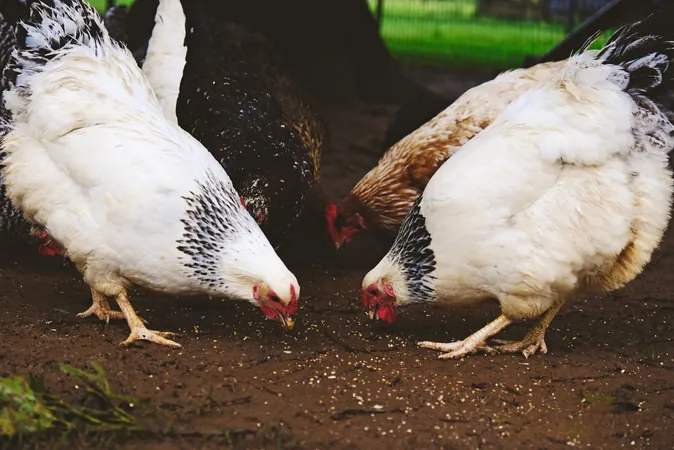
Unveiling the Secrets of the Poultry Gut: How Microbiome Regulation Influences Health and Performance
2024-12-30
Author: Yu
Understanding Poultry Gut Health
Understanding what constitutes a ‘healthy gut’ in poultry goes beyond simple definitions; it requires delving into the intricate interactions within the enteric microbiome ecosystem. This dynamic system, composed of a vast array of microbes, plays a pivotal role in influencing not only the gut health of birds but also their overall performance in production.
Recent studies reveal an exciting discovery: the host chicken has an active role in controlling its microbiota through several mechanisms. Historically, research has emphasized the microbiota's role in gut health maintenance, but new findings suggest that the host can shape this microbial community to promote beneficial traits that enhance its performance and well-being.
The Microbiota as a Functional Organ
In the chicken gut resides an astonishingly complex microbial community, often referred to as a ‘functional organ’ due to its critical roles. With trillions of microorganisms—predominantly bacteria—comprising over 500 phylotypes, the microbiota profoundly influences nutrient assimilation and energy balance. Not only does it assist in breaking down dietary fibers for energy, but it also acts as a neuroendocrine organ, producing metabolites that interact with various organs and systems throughout the body.
Another central function of the gut microbiota is its ability to fend off pathogens through a process known as colonization resistance. By occupying ecological niches and secreting metabolic byproducts, beneficial bacteria can inhibit the growth of harmful organisms, thereby safeguarding the gut's health.
Host Mechanisms: Shaping the Microbiota
Chickens actively maintain a healthy microbiota by employing several ecological ‘filters’: gut epithelial cells, immune systems, and the enteric nervous system all work together to modulate microbial composition.
Epithelial cells form a selective barrier, absorbing nutrients while constantly interacting with a multitude of environmental influences. These cells respond to diet and microbial metabolites, engaging both immune and nervous systems to sustain gut health. For instance, Paneth cells in the intestine release antimicrobial peptides, fostering a conducive environment for beneficial microbes and outcompeting pathogenic ones for limited resources.
Immune System Collaboration
The relationship between the gut microbiota and poultry’s immune system is multifaceted. The immune system not only protects against pathogenic invaders but also encourages the proliferation of beneficial microbial strains. Both the innate and adaptive immune responses are integral to maintaining a balanced microbiome, suggesting that a well-regulated immune system can lead to improved poultry health outcomes.
Recent evidence supports the idea that the immune system acts as an ecological filter, shaping microbial communities while ensuring that the gut remains a hospitable environment for friendly bacteria.
The Role of the Enteric Nervous System
Moreover, the enteric nervous system (ENS) adds another layer to this complex network, playing key roles in regulating gastrointestinal functions such as motility, nutrient absorption, and immune responses. The ENS interacts closely with microbial communities, suggesting a significant relationship where microbiota influence neural health and function, impacting overall gut welfare.
A Shift Towards Non-Antibiotic Solutions
With the poultry industry increasingly moving away from antibiotic growth promoters (AGPs) due to regulatory changes and consumer demand for healthier, more sustainable production methods, there is a strategic pivot towards understanding how to manipulate the gut microbiome for better health outcomes. Innovations in prebiotics, probiotics, and postbiotics are emerging as potential solutions.
This shift represents an opportunity not only to enhance poultry performance but also to address pressing concerns about animal welfare and health management, underscoring the necessity of integrating knowledge about the microbiome with practical applications in poultry farming.
Conclusion: The Future of Poultry Health is in Understanding the Gut
The quest for optimal gut health in poultry goes hand-in-hand with advances in our understanding of the delicate balance between host and microbiota interactions. As we unveil the layers of this complex relationship, the focus shifts to developing innovative strategies that leverage this knowledge for healthier livestock, improved productivity, and better environmental outcomes. Ultimately, a well-regulated microbial ecosystem in the gut may well hold the key to unlocking the full genetic potential of poultry, marking a transformative stride in agricultural practices worldwide.
 Brasil (PT)
Brasil (PT)
 Canada (EN)
Canada (EN)
 Chile (ES)
Chile (ES)
 Česko (CS)
Česko (CS)
 대한민국 (KO)
대한민국 (KO)
 España (ES)
España (ES)
 France (FR)
France (FR)
 Hong Kong (EN)
Hong Kong (EN)
 Italia (IT)
Italia (IT)
 日本 (JA)
日本 (JA)
 Magyarország (HU)
Magyarország (HU)
 Norge (NO)
Norge (NO)
 Polska (PL)
Polska (PL)
 Schweiz (DE)
Schweiz (DE)
 Singapore (EN)
Singapore (EN)
 Sverige (SV)
Sverige (SV)
 Suomi (FI)
Suomi (FI)
 Türkiye (TR)
Türkiye (TR)
 الإمارات العربية المتحدة (AR)
الإمارات العربية المتحدة (AR)